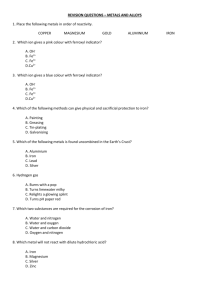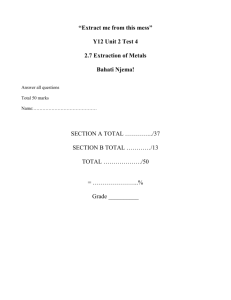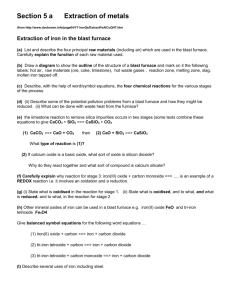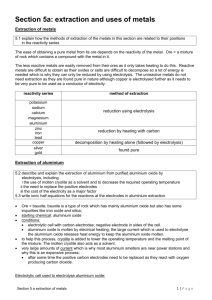Production and Use of Metals
advertisement
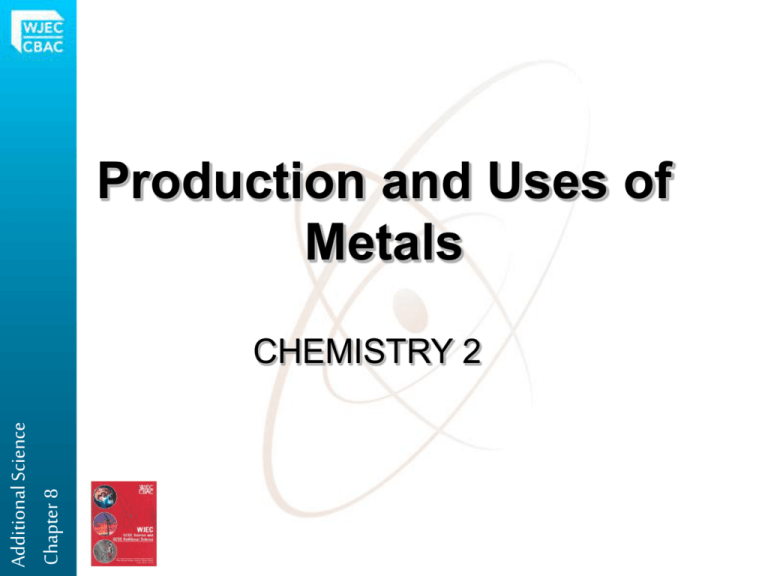
Production and Uses of Metals Additional Science Chapter 8 CHEMISTRY 2 Metallic minerals The least reactive metals occur in an uncombined form within the Earth’s crust. e.g. gold The other metals exist as ores in combination with other elements such as oxygen and sulphur. Pyrite Haematite Additional Science Chapter 8 (a mineral of iron sulphide) (a mineral of iron - oxide) Metals are produced from their ores by a process called reduction. Iron pan The reactivity series of metals Different metals have different reactivities. A more reactive metal will remove oxygen from the oxide of a less reactive metal when a mixture of the two is heated. When a mixture of powdered aluminium and iron(III) oxide is ignited by a high temperature fuse, molten iron is formed. This reaction is called the thermit reaction and is used to weld sections of railway track. Additional Science Chapter 8 A mixture of aluminium and iron(III) oxide reacting together railway track crucible railway track The reactivity series of metals This table shows the reactivity series of common metals, and how they are extracted from their ores. Reactivity Strong Element Extraction method K (Potassium) Na (Sodium) Reaction with acid Too dangerous Electrolysis Ca (Calcium) Mg (Magnesium) Releases hydrogen and dilute hydrochloric acid. Zn (Zinc) Fe (Iron) Additional Science Chapter 8 Sn (Tin) Cu (Copper) Weak Ag (Silver) Chemical reduction Doesn’t release hydrogen and dilute hydrochloric acid. Extracting iron from its ore Chemical reduction with carbon 1. Raw materials (iron ore, coke and limestone) are added at the top of the furnace. 2. Blasts of hot air (which give the furnace its name) are blown in near the bottom of the furnace. Load if iron ore, coke and limestone 3. Oxygen in the blasts of air reacts with coke (carbon) to form carbon monoxide. 2C + O2 2CO Gas outlet This reaction is very exothermic and the temperature in the furnace reached 2000°C. The blast furnace 1000°C 4. As the carbon monoxide rises up the furnace, it reacts with the iron ore (iron(III) oxide to form iron. 1500°C Fe2O3 + 3CO 2Fe + 3CO2 2000°C Blasts of hot air Blasts of hot air Molten slag (impurities) Outlet for molten iron Outlet for the slag Molten iron 5. Molten iron runs to the bottom of the furnace. It is tapped off from time to time. 6. The molten iron is used to make steel or poured into moulds to solidify. The large chunks of iron formed are called ‘pigs’ so this metal is called ‘pig iron’. Steel – properties and uses Iron from the blast furnace is very brittle because it contains up to 4.5% carbon. Most of this iron is converted to steel, which is far more useful, by removing most of the carbon. Mild steel contains approximately 0.5% carbon. Hard steel contains up to 1.5% carbon. Car bodies machines Domestic appliances It is possible to treat steel . Additional Science Chapter 8 Heat treatment Creating alloys with other metals Stainless steel (chromium and nickel) Very hard steel (tungsten) Tough steel (manganese) Tinplate Recycling steel Steel is recycled on a large scale. Additional Science Chapter 8 Saves up to 50% of energy costs Helps to conserve iron ore Cuts down the emission of greenhouse gases Electrolysis – background Electrodes Conducting liquid – Additional Science Chapter 8 electrolyte Electrolysis is a chemical reaction. Current enters the electrolyte via two solid conductors called electrodes. Electrolysis – background Positive electrode ion+ ionion- ion+ ion+ ion- Additional Science Chapter 8 ion- ion+ Negative Electrode Electrolyte The anode is the positive electrode, and the cathode is the negative electrode. The positive ions (cations) move towards the negative electrode, and the negative ions (anions) move towards the positive electrodes. Electrolysis – extraction of reactive metals Remove impurities by chemical method Bauxite – a rock containing aluminium Aluminium oxide powder (alumina), with a very high melting point Electrolysis of aluminium oxide (alumina) carbon anodes crust of solidified electrolyte 1. Aluminium oxide is dissolved in molten cryolite (about 950°C). Additional Science Chapter 8 2. Oxygen gas is formed at the aluminium carbon anodes, and at that high oxide in molten cryolite temperature the anodes react with oxygen, burning away and having to be replaced from time to time. Molten aluminium tap hole insulated cell casing carbon lining to cell acting as the cathode 3. Aluminium in the form of a molten metal forms at the cathode. 4. The tap hole is used to collect the aluminium, the crust needs to be broken to add more aluminium oxide. The equations for the reaction: Additional Science Chapter 8 Positive aluminium ions are attracted to the negative cathode, where they gain electrons and form aluminium metal. Al3+ +3e Al 2O2- -4e O2 Negative oxide ions are attracted to the positive anode, where they lose electrons and form oxygen gas. Locating aluminium works The raw materials and the product need to be transported easily A lot of electricity is required for producing the metal via electrolysis A good transport network in and out Build aluminium works near cheap sources of electricity Port Railway links Additional Science Chapter 8 Roads Hydroelectric Power Source Nuclear Power Station Properties of aluminium light strong density of 2.7g/cm3 resistant to corrosion layer of aluminium oxide (this prevents corrosion even though the metal is very reactive) Using aluminium Additional Science Chapter 8 Use 1. High voltage power cables for the Reason Light, resistant to corrosion National Grid 2. Saucepans and kitchen foil Good conductor of heat, non toxic 3. Window frames and greenhouses Strong and light 4. Drinks cans Strong and non toxic 5. Aeroplane and car bodies Strong and resistant to corrosion Properties of copper excellent conductor of electricity and heat malleable ductile non toxic Use of copper Additional Science Chapter 8 Use Reason 1. Wires in electrical circuits Good conductor of heat 2. Saucepans Good conductor of heat and non toxic 3. Jewellery Malleable and ductile, attractive colour and lustre 4. Water pipes Non toxic and malleable 5. Produces the alloy bronze (copper + tin) and brass (copper + zinc) Properties of titanium good conductor of heat and electricity light strong tough high melting point non toxic low density non corrosive Using titanium Additional Science Chapter 8 Use Reason 1. Aircraft industry Light, tough, non corrosive 2. Surgical equipment Light, tough, non corrosive 3. Artificial joints, plates for bone fractures Non toxic, light, tough, non corrosive 4. Jewellery Non toxic 5. Titanium dioxide is the basis of white paint. The consequences of metal extraction Disadvantages Advantages When the ore runs out, the mine workings may be abandoned causing a deterioration of the landscape. Extraction and processing of minerals creates employment. Importing metals is very expensive for the country. Sometimes less useful and toxic metals are found with the ones that are needed. Additional Science Chapter 8 Important for the economy (Economic boom in the UK during Industrial Revolution). Processing minerals have a detrimental effect on the environment. Fluctuations in the cost of metals can affect the economy. A lot of electricity is needed to produce aluminium. Many minerals are sulphides – produce sulphur dioxide (the gas that causes acid rain).
